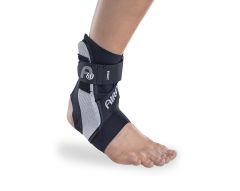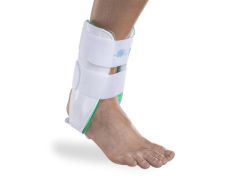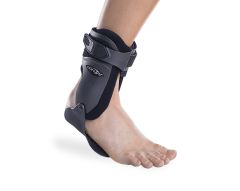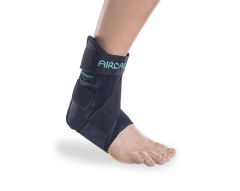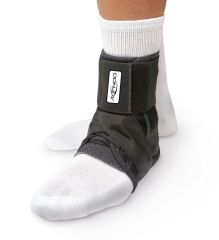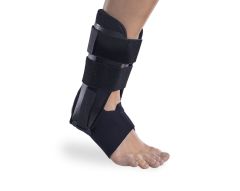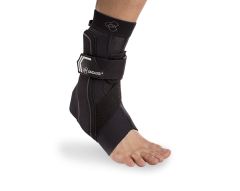Ankle Sprain
All About Ankle Sprains
Quick Facts About Ankle Sprains
Your ankles have an extremely important job to do. They support the weight of your entire body in most daily activities and allow you to walk, run, jump and turn. As a result of this great responsibility, the ankles are also one of the most frequently injured areas of the body, and at the top of this list is the well-known ankle sprain.
Ankle sprains, which account for the majority of all ankle injuries, involve the stretching or tearing of ligaments and are characterized by a certain amount of pain, swelling and/or tenderness. Though ankle sprains are seen most regularly during sports and other physical activities, they can occur any time the ankle is improperly moved beyond its limits.
For a visual guide to ankle sprains, check out our "Everything You Need to Know About Ankle Sprains" Infographic.
TopHow Prevalent are Ankle Sprains?
- Ankle sprains are considered the most frequent type of musculoskeletal (involving the muscles and bones) injury seen by primary-care doctors
- They are the most common injury in the athletic population, as they are responsible for up to 45% of all sports injuries
- Approximately 25,000 people sprain their ankle in the U.S. every day
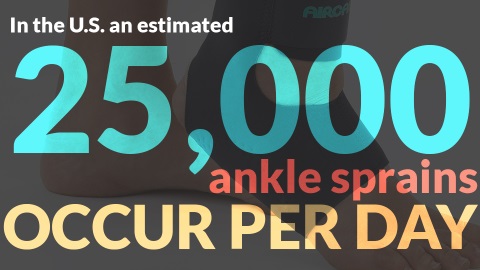
Top
Who’s at Risk?
- Nearly half (49.3%) of all ankle sprains occur during athletic activity
- 41% of all sports-related ankle sprains are due to basketball, followed by football (9.3%) and soccer (7.9%); any other physical activities that feature regular jumping and/or cutting movements also present more of a risk
- Ankle sprains can occur at any age, but are typically seen in those younger than 50; the highest rates recorded are between ages 10-19, primarily in the young athletic population
- The greatest risk factor is a previous ankle sprain: suffering from one ankle sprain can cause you to be at least twice as likely to experience another one within the next year
How Do Ankle Sprains Occur?
- An ankle sprain can happen any time the foot twists, turns or rolls beyond its normal range of motion
- In basketball, almost half of ankle sprains are experienced due to landing wrong, with half of these (25% of total) from landing on another player’s foot; sharp twists or turns (30%) and collisions (10%) are also common
- Outside of sports, any other scenario that leads to this type of improper movement can also cause them; some examples include stepping off a curb wrong, slipping on ice, walking down stairs, running on uneven surfaces or into a hole, and tripping on a hazardous object
What Happens When You Sprain Your Ankle?
An ankle sprain does not affect your bones—which are usually untouched unless there’s a break or fracture—but the ligaments of the ankle that connect the bones together.
The ankle joint is made up of three bones:- Tibia- the shinbone, the major bone of the lower leg, which bears most of the body’s weight
- Fibula- the other, thinner bone in the lower leg, which helps with stabilizing the ankle and supporting surrounding muscles
- Talus- a small bone at the top of the foot that helps transfer weight and pressure forces across the ankle joint
Surrounding these bones are a number of tendons and ligaments. Tendons are cords of strong tissue that connect muscles to bones, and several muscles control the motion of the ankle through them. Each muscle has a tendon connecting it to one or more bones of the foot.
Ligaments are flexible bands of tissue that connect one bone to another. They bind joints together and provide stability by limiting side-to-side movement and protect joints from abnormal movements. Ligaments are elastic structures, meaning they can stretch within their limits and then return to their normal position, but when they stretch beyond their normal range, damage can occur. Since the ankle is made up of a number of bones, it contains numerous ligaments needed to hold it together. An ankle sprain is due to any force that causes one or more ligaments of the ankle to stretch too far, which can result in a tear.
TopWhat are the Symptoms?
If you happen to incorrectly move your ankle in any of the ways described above and experience a sprain, the area will become inflamed as a result of the body’s natural defense system. This will lead to some or all of these three symptoms:
- Pain in and around the ankle, which is due to nerves being more sensitive; your joints will usually become more tender and may throb as well
- Swelling from the increased fluid in the damaged tissue
- Redness and warmth caused by the increased blood flow to the area
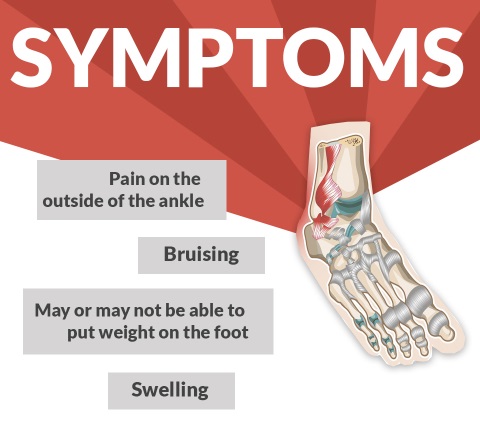 Top
TopTypes of Ankle Sprains
Three degrees of ankle sprains
Depending on the type of incident and the amount of force applied, ankle sprains can range from mild to severe. To make it easier to determine how serious a sprain is, a classification system of three different grades, or degrees, is used. By knowing the signs and symptoms of each of these degrees, you’ll be better able to decide what treatment is necessary and if you need to see a doctor.
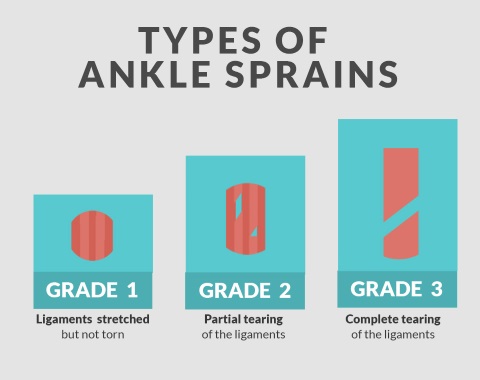
1st degree (mild)
- Ligament(s) stretched, and some damage occurs to its fibers, but there is no tear
- Symptoms: mild pain and tenderness, some swelling and stiffness and possible difficulty jogging or jumping
2nd degree (moderate)
- The most common degree of ankle sprain
- Ligament(s) partially torn
- Symptoms: significant swelling and bruising, moderate pain, trouble walking, some loss of motion or use of ankle, possible instability
3rd degree (severe)
- Ligament(s) completely torn
- Symptoms: severe swelling and pain, especially while walking, instability of joint, extreme loss of motion, possible difficulty bearing weight on foot
- In some cases you may hear a “pop” sound with this type of sprain
Learn more about the degrees of ankle sprains.
Inversion vs. Eversion
Inversion- the result of the foot twisting inward and stretching the outer ligaments too far, leading to pain only on the outside of the ankle; these are the more common of the two causes, as about 80% of all ankle sprains are the result of inversion
Eversion- the opposite, with the foot twisting outward and stretching the inner ligaments too far, leading to pain only on the inside of the ankle
Location: Lateral, Medial or High
- Depending on its location in the ankle, a sprain can be further categorized as either lateral, medial or high
- A lateral ankle sprain is another term used to describe an inversion sprain, but in this case refers to the sprain taking place on the outside part of the ankle; as stated above, this is the most common site for a sprain (~80%)
- High, or syndesmotic ankle sprains are more rare (up to 15% of sprains) and are often seen in football, downhill skiing and other field sports
- Medial sprains only account for 5-6% of all ankle sprains
- Syndesmotic and medial ankle sprains take considerably longer to heal and require different treatment strategies than lateral ankle sprains
When do I need to see a doctor?
In most cases, it’s your choice whether you’d like to see a doctor or not for your ankle sprain. Your doctor will be able to provide a complete diagnosis and direct you towards the best possible treatment, but is not always necessary; however, if your pain is uncontrollable, you can’t walk or your ankle doesn’t noticeably improve in one week, then it’s strongly recommended that you visit a doctor. Here’s what will happen:
- The doctor will perform a complete examination and evaluation of your ankle by moving it in multiple directions to determine how the ligament has been injured and what degree the sprain is based on the amount of pain, swelling and bruising
- If your sprain was severe enough, the doctor may order an X-ray to make sure no bones have been broken
- In rare cases a magnetic resonance imaging (MRI) scan may also be ordered to confirm the doctor’s diagnosis
- The doctor will then prescribe specific treatments that should consist of home remedies, physical therapy and bracing to rehabilitate your ankle
The Best Ways to Treat an Ankle Sprain
The prognosis for the majority of ankle sprains is quite good. The exact recovery time will depend on the severity of the sprain, but most will only need a period of 4-6 weeks protection to heal properly. With the right treatment, most people are able to eventually return to their normal lives, sports and activities without any major complications. Even a 3rd degree sprain with a complete ligament tear doesn’t require surgery and can heal—albeit with some additional time than a 1st or 2nd degree sprain—if it’s cared for properly.
Without appropriate treatment, though, serious problems can arise such as decreased range of motion, chronic (long-lasting) pain and swelling, and joint instability. These issues can limit your overall mobility and abilities, making the recovery process even longer and more difficult. It’s therefore absolutely necessary that you care for your ankle sprain and adhere to the following course of treatment:
TopRICE
The RICE method is one of the easiest and most popular ways for you to take control of treating your ankle sprain and helping your ankle heal quicker. It focuses on reducing inflammation and consists of four parts:

- Rest: rest your ankle and avoid putting any pressure on it; if advised by your doctor, crutches and/or some type of ankle support may be used until walking is no longer painful
- Ice: immediately apply ice to keep swelling down; ice your ankle for 20 minutes, 3-4 times daily, for the first 1-3 days after the sprain or until swelling decreases
- Compression: dressings, bandages or elastic wraps should be used to immobilize and support your ankle for the first 24-36 hours after the sprain; compression wraps don’t offer protection, and a protective brace should be used if you’re trying to bear weight on the injured ankle; (the Aircast Ankle Cryo/Cuff with Cooler offers both compression and cold therapy to the ankle and can help speed recovery)
- Elevation: raise your injured limb above the level of your heart for at least 2-3 hours a day for the first 24-36 hours after injury to prevent swelling and bruising; you can do this by lying on your back and propping your leg up on some pillows
- The RICE method is strongly recommended and effective for 1st and 2nd degree ankle sprains, though 2nd degree sprains will require more time
Physical therapy
Physical therapy is considered an essential component of treatment for ankle sprains that will drastically facilitate your recovery process. The overall goal of physical therapy is to reduce your pain and swelling, improve your stability and proprioception (your perception of how your body moves), and return you to your previous level of activity before the sprain. Physical therapy is also effective for keeping your ankle healed and preventing more injuries in the future.
Unless your ankle sprain is severe, physical therapy can usually begin soon after the injury, sometimes along with additional treatments like bracing, taping or splinting the ankle. The rehabilitation process for your sprained ankle will vary in each case depending on its severity, but it can be roughly grouped into three separate phases:
- Phase 1 (restriction): includes resting, protecting the ankle and reducing the swelling; RICE is considered part of this phase and it should be carried out for the first week
- Phase 2 (restoration): focuses on restoring the ankle’s range of motion, strength and flexibility through a series of exercises; lasts for 1-2 weeks
- Phase 3 (reacquisition and refinement): helps you gradually return to activities that don’t require and twisting or turning of the ankle through specific exercises; eventually you’ll work your way back to cutting activities with sharp, sudden turns; the physical therapist will also help determine when you’re ready to return to sports during this phase, which can last several weeks up to months
Physical therapy treatment programs may differ from one practice to the next, but most of them will feature some of these components:
- Range of motion exercises: the swelling and pain from an ankle sprain can lead to limited mobility, but these exercises are designed to restore your ankle movement
- Muscle strengthening exercises: not being able to move your ankle properly can cause weakness and eventually long-term ankle instability, which will increase the risk for future injuries; strengthening the ankle will help you regain your strength and prevent this from happening
- Body awareness and balance training: this part of rehab will improve your overall balance and help your muscles learn to respond to any potential hazards such as an uneven or unstable surface
- Functional training: as you improve, your treatment will progress to include some of the activities you were doing before the sprain that you have difficulty with, such as walking, jogging or jumping
- Activity-specific training: if you’re trying to return to a sport or job that demands even more from your ankle, additional rehab may be needed; this training will be specifically catered to your sport/activity/job and will gradually bring you back to a point where you can perform necessary movements properly and pain-free
Braces and supports
The RICE method and physical therapy are both effective approaches that will be sure to improve your condition, but a comprehensive treatment program is not complete without the addition of an ankle brace. RICE and physical therapy will reduce inflammation and get you to move your ankle more easily, but they fail to provide protection and stability. That’s where these ankle devices come in.
Ankle braces and supports are needed to protect the ligaments in your ankle as they heal and prevent further damage from occurring. These devices are especially important for active athletes who are attempting to slowly return to their sport, as additional stability is needed to keep their ankles safe while participating in difficult movements. We offer a wide range of braces for every step of the recovery process that will help treat and protect your ankle sprain, no matter how severe, and get you back to doing what you love in no time.
TopSelecting the right brace for your ankle sprain
To treat an acute ankle sprain—meaning it happened approximately within the past six weeks and is not chronic, or long-lasting—we recommend the following:
- Aircast A60- treats 1st and 2nd degree sprains
- Aircast Air Stirrup- provides support and compression; designed to allow you to continue daily activities while recovering; ideal for 3rd degree sprains
- DonJoy Velocity- extremely comfortable but offers extra level of support; used for any inversion or eversion ankle sprains
- Aircast Airsport- combines compression and stabilization; easy to apply; ideal for 1st and 2nd degree sprains
Most of these braces, as well as many of our other featured products, also treat a condition known as chronic ankle instability and help prevent future ankle injuries. Need help? Use this guide on choosing an ankle brace for recommendations.
Click here for detailed descriptions on our entire line of ankle braces and supports.
How to Keep Your Ankle Safe and Prevent Future Injury
Though the outcome for most ankle sprains is good if proper treatment is given and instructions are followed, there is one unfortunate catch: having just one ankle sprain will make you at least twice as likely to experience another one within the next year. Additional ankle sprains can happen in any number of ways like the first one, but they usually result from returning to sports too soon. In these cases, the ligaments are not given enough time to heal or the ankle may not have yet returned to full strength, and a sprain can be experienced once again.
Some people who sprain their ankle a second time eventually may fall into a cycle of reinjuring the same ankle over and over. This process can lead to a condition called chronic ankle instability (CAI):
- People with CAI often experience episodes of instability or the ankle “giving way” while walking, doing activities or simply standing
- Chronic pain, discomfort, swelling and tenderness are common
- Certain activities that require cutting actions like basketball, tennis, football and soccer can make the condition even worse
- If not addressed, CAI can cause patients to repeatedly sprain their ankles, leading to long-term disability
Reduce your risk of developing Chronic Ankle Instability with bracing
If you’ve recently sprained your ankle, the good news is there are a number of simple steps you can take to ensure you won’t go on to develop CAI. The best way to accomplish this and prevent future ankle sprains is to maintain the improvements in strength, muscle balance and flexibility that you acquired through your rehab program. Your physical therapist can give you additional exercises to perform after being discharged to keep your ankles strong and flexible. You should also:
- Follow your doctor or physical therapist’s recommendations and do not return to sports before you’re instructed to
- Warm up before any exercise or vigorous activity and stretch your ankles
- Wear the proper shoes for the sport/activity you’re participating in; shoes should be stable and give your ankles adequate support
- Be aware of all surfaces you walk or run on and avoid any uneven or unstable ones
- Pay attention to your body’s warning signs and slow down when you feel any pain or fatigue
- Wear an ankle brace or support
Braces provide the ankle with the stability, support and protection needed for getting around in everyday life and most importantly, during athletic performance, when the ankle is most vulnerable. Our braces are regularly tested and have been supported by numerous research studies in their ability to decrease the risk of future ankle sprains both for those with CAI and those who may go on to develop it.
If you’re concerned with your ankle’s future and fear that you may fall into the trap of CAI and long-term disability, look no further. The line of braces we offer are the most simple, affordable and effective way you can get back to participating in the sports or activities you love without having to worry about experiencing another sprain. Best of all, our braces are designed for comfort, meaning they’ll do their job of keeping your ankle protected but won’t feel bulky or get in the way of your performance. For a complete list of our braces, click here.
TopBest braces for self-treatment and preventing CAI and future ankle injuries
- DonJoy Stabilizing PRO- this lace-up brace can easily fit into any shoe and is designed for the needs of demanding athletes in any sport, especially basketball; can prevent both initial and future ankle injuries
- ProCare Universal Ankle Brace- prevents inversion and eversion and is effective for treating acute sprains or CAI)
- DonJoy Performance Bionic Ankle - prevents ankle roll; moderate support ideal for chronic instability
- DonJoy Velocity- though it may be somewhat more restrictive, along with the Air Stirrup, these braces offer the highest level of stability for those healing from an ankle sprain or looking to prevent future incidents





